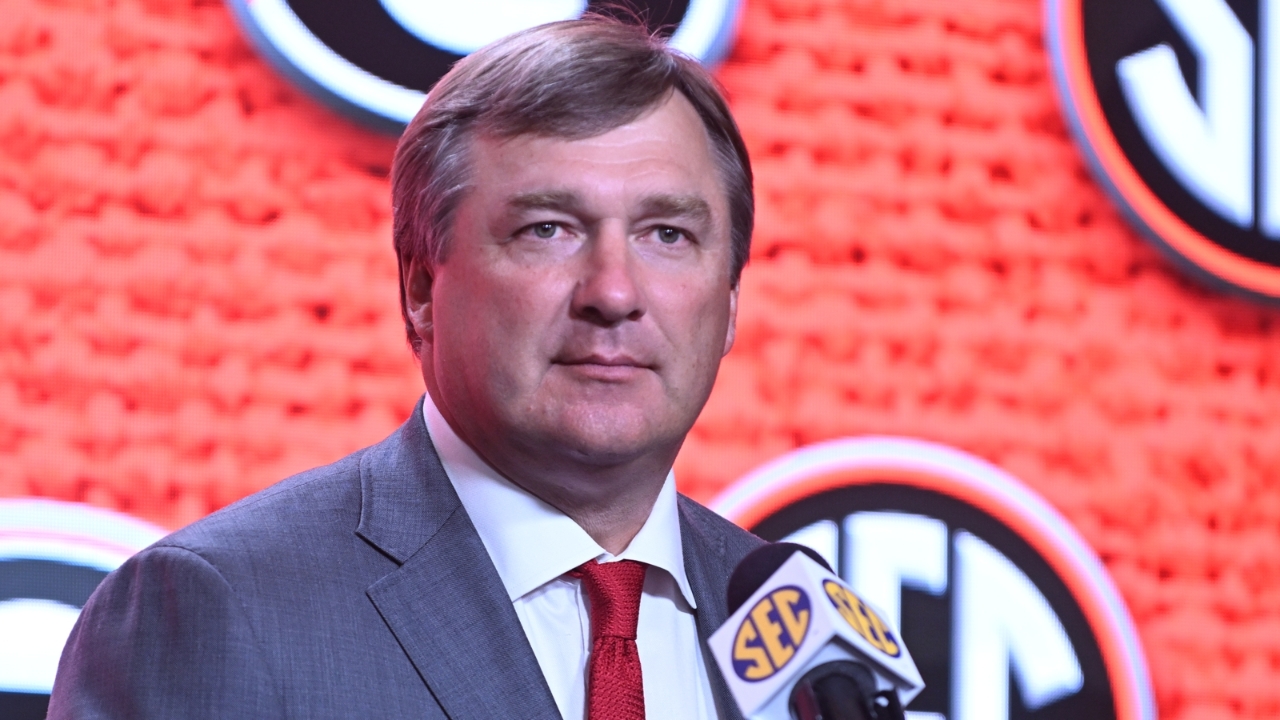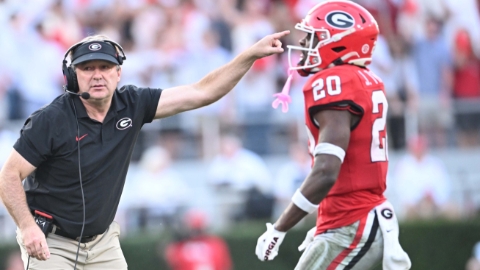Maybe Georgia Bulldogs Coach Kirby Smart Has the Winning NIL Formula Too?

DON’T MISS OUT: Get our insider newsletter today!
ATHENS -Coach Kirby Smart has built the Georgia Bulldogs into not only a College Football Playoff National Champion, but a yearly contender for the title. Smart has built a replicable machine designed to contend every year for SEC Championships and the CFP Playoffs, as opposed to teams finding lightning (aka Joe Burrow or Jameis Winston) in a bottle one year only to suffer a precipitous fall the next. While some programs have received more Name Image Likeness (NIL) “buzz” than Georgia recently, do not be fooled by this fool’s gold. NIL rights afforded to college players introduced a new aspect to recruiting and so far, the way Kirby Smart is navigating NIL, again seems like a sustainable winning formula.
Kirby has elevated Bulldog recruiting to the point where it can be choosy among the blue-chip recruits it is willing to sign. In most cases Georgia signs those that not only have the raw talent, but also have a better chance than their peers to reach their potential. The players Kirby now signs are those that seem most willing to “buy-in” to Georgia’s team-first mentality and to a work-ethic required to survive the rigors of the SEC and the classroom.
In general, there are essentially two types of NIL deals. On the one hand, there are NIL deals that allow college players to endorse products or services and, thus, earn money from their notoriety. While on the other hand, there are essentially (now legal) payments to high school players as an “inducement” to sign with a team. Yes, NCAA rules still prohibit “pay-for-play” and prohibit NIL deals that “induce” a player to sign with a team. Nevertheless, for the purposes of this article, gussied-up NIL deals that are technically rule compliant – e.g., a booster’s unsigned offer of a lucrative endorsement deal for a recruit, “wink” “nod” if he signed with a team – are referred to as “inducement” deals as they are offered to players that have not yet played for a given team.
Celebrate Georgia's 2021 NATIONAL TITLE
Check out DAWGSTRUCTION NOW!
Most agree that allowing players to earn money from their on-field “earned” commercial appeal (i.e.,
what NIL was ostensibly designed for) makes sense and was long overdue. The other type of NIL deal, often involving big money boosters shelling out large sums in the hopes of improving their favorite team’s roster, can “technically” be done within the rules, but raise additional concerns.
In both scenarios whomever is writing the check is seeking a type of return on investment (ROI). A
company’s ROI in an NIL deal is similar to its other marketing campaigns. They will choose athlete
endorsers that they think the public will respond to, usually based upon a player’s on-field performance.
Of course, it would seem more prudent, and likely, for national brands risking significant money on
advertising campaigns, to choose players that have already excelled, rather than simply having the
“hype” and potential of doing so. Perhaps recent Dr. Pepper® commercials are a harbinger of NIL-related course corrections to follow, under both NIL approaches. Before the first play of the 2021 season, Clemson Quarterback DJ Uiagalelei who had (and has) yet to fulfil his potential, appeared in a national commercial spot, while a year later it was Heisman Trophy Winner Bryce Young appearing in a similar ad.
Kirby Smart has stated publicly that Georgia’s NIL plan, through collectives and the like, is generally to reward those players that have already been in the Georgia Football system and have produced on the field. Smart indicated recently that 95 players on the team were benefiting from NIL. At the same time, it has been clear that Georgia’s NIL backers will not get into bidding wars to “induce” a player to sign.
Smart has indicated that if a recruit’s number one interest is NIL money, then Georgia is not the right place for him. Rather, Kirby has explained that NIL should be one of the things that attracts a player, along with his fit into the Georgia team culture, a desire to develop himself for an NFL career that can be far more lucrative than NIL deals, and the desire to get an education and prepare for life after football.
Desperate boosters and programs seeking to induce blue-chip recruits to sign in the hopes of bringing home a National Championship take far greater risks with those signees. Some players may be blinded by the riches offered from a highest bidding team, that might not otherwise be a good fit. Again, Georgia players can and will get NIL money, and plenty of it, if they succeed on the field. Stetson Bennett has been reported to have inked more than a million dollars in NIL deals since his National Championship heroics. Yet, at a place like Georgia, Kirby demands a team first buy-in. Players must grind and be prepared to wait their turn if they are not ready to play early – and few are.
Texas A&M is one of the interesting “test cases” for what seems to be a very non-Kirby gameplan for NIL and roster building. It has been reported that tens of millions of dollars were spent by friends of Texas A&M Football to encourage high school players to be part of the Aggie’s 2022 recruiting class. It should be noted that the assumption here is that everything done on A&M’s behalf was done legally and within the current NCAA rules. However, this model seems problematic and not built to last.
Coach Jimbo Fisher (perhaps looking for his next Winston in a Bottle), went from being a solid recruiter – averaging approximately the 8 th best recruiting class nationally (and 4 th best in the SEC) in his first four years at A&M – to an eye-popping Brady Anderson-like year in 2022, when A&M signed the best recruiting class ever! For those not old enough to remember, Brady Anderson was a baseball player, mostly for the Baltimore Orioles, who averaged 9 homeruns per year from 1988 through 1995, and then inexplicably hit 50 homeruns in 1996! After that allegedly “pumped-up” 1996 season, Anderson averaged approximately 15 homeruns per year for the rest of his career. In case anyone forgot, Texas A&M’s own eyebrow-raising historic recruiting class, was coming off an 8-4 record in 2021, and that was the third time in the four years of Fisher’s A&M tenure that the Aggies lost four or more games.
It is not just because A&M has had an uninspiring start to the 2022 Season that its sudden otherworldly recruiting does not seem replicable. To be sure, the 12 th Men may get restless wondering if their lavish spending is making an impact on the field. However, well before the 2022 season began, the A&M NIL plan was looking a little “Fisch-ey,” as the big money Aggie people seemed to be taking a wait-and-see approach before making it rain again in College Station. While there are still a few months left in the 2023 recruiting cycle, the apparent new recruiting homerun king that is A&M, went from the best class ever in 2022, to sitting for months now at around the 24 th best nationally with currently only 11 commits – well below even their pre-2022 standard.
Ole’ Miss Coach Lane Kiffin speaking about NIL recently said that as in the NFL, eventually college
coaches are likely to feel pressure to play higher paid players. In college football, payments by boosters set up obvious clashes between them and any coach whose job is not too secure – and in the age of big money booster NIL inducement deals, that could include most of them.
Before the 2022 season began, questions were being raised as to whether “people” were living up to
their NIL promises. There were some vague reports of grumblings from players that felt they were not getting the NIL deal they expected when they arrived on campus. Without knowing what was promised or seeing the contracts themselves, there is no way to know, but as they say the devil is in the details – and this is likely no truer than in the NIL contract context. What seems certain, however, is that there will be unavoidable conflicts between and among players, boosters, and coaches, regardless of what these “inducement” NIL contracts say and even if they are written exactly as a player expected.
It is highly likely that in many instances NIL monies “promised” to entice a recruit to sign are not quite guaranteed. NCAA rules prohibit performance-based NIL – e.g., tying payments to incentives or
benchmarks met like a certain number of snaps played, or a statistical measure hit. Nonetheless, it
would seem obvious that boosters have ways to avoid future “promised” payment obligations to a
player that underperforms on the field or transfers. There are many simple ways to accomplish this goal from a compliant NIL contract perspective, including NIL contracts that are terminable by the parties and/or that are of a short duration with renewal options.
Nonetheless, whether these NIL deals are truly guaranteed or not, there will undoubtably be problems – just different problems. For example, it stands to reason that if NIL money is really “guaranteed” to high school recruits before they have made a single play on the field, it will lead to unrest from boosters and team veterans alike if the recent signees are being paid more than others but are not seeing playing time or performing as expected. And it equally stands to reason that if the NIL agreements are not guaranteed (e.g., they can be easily terminated and/or not renewed), then there will be unrest from bench warming NIL recruits themselves. Besides now becoming high transfer risks, they may also blame coaches for getting in the way of their payday. Regardless, building a roster with NIL-inducement deals, does not seem like a sustainable model.
In contrast, Kirby’s NIL strategy seems to fit hand in glove with Georgia’s overall player acquisition and development culture. Smart’s message is that if a player puts in the work, he will get NIL money and likely more of it if he is willing to make himself better. And if a Georgia player is willing to work and waits his turn, he may only need one year of “tape” to be an early round NFL draft choice and enjoy NFL riches far exceeding NIL money. Kirby can now point to the “proof of concept” exhibited by Georgia’s historic showing in the 2022 NFL Draft. Of course, for many years, and well before NIL, this was what only Alabama (often with Kirby’s help) had been able to do: i.e., convince blue-chip recruits to join a stacked depth chart, wait, learn, and develop for the NFL.
Kirby is demonstrating that even in the NIL and transfer portal era, Georgia still has the winning formula. Kirby has been seeking, and in most cases is able to sign, the rare uber-talented young person who is willing to delay (some) gratification for a larger gain down the road, despite being enticed by other programs with promises of greater immediate riches. Kirby’s program building approach to signing and managing blue-chips is like a sound long-term investment strategy that involves a different kind of blue chip, while some team’s methods seem more akin to speculation on a meme stock or a never ending chase after the latest loud and shiny thing.




